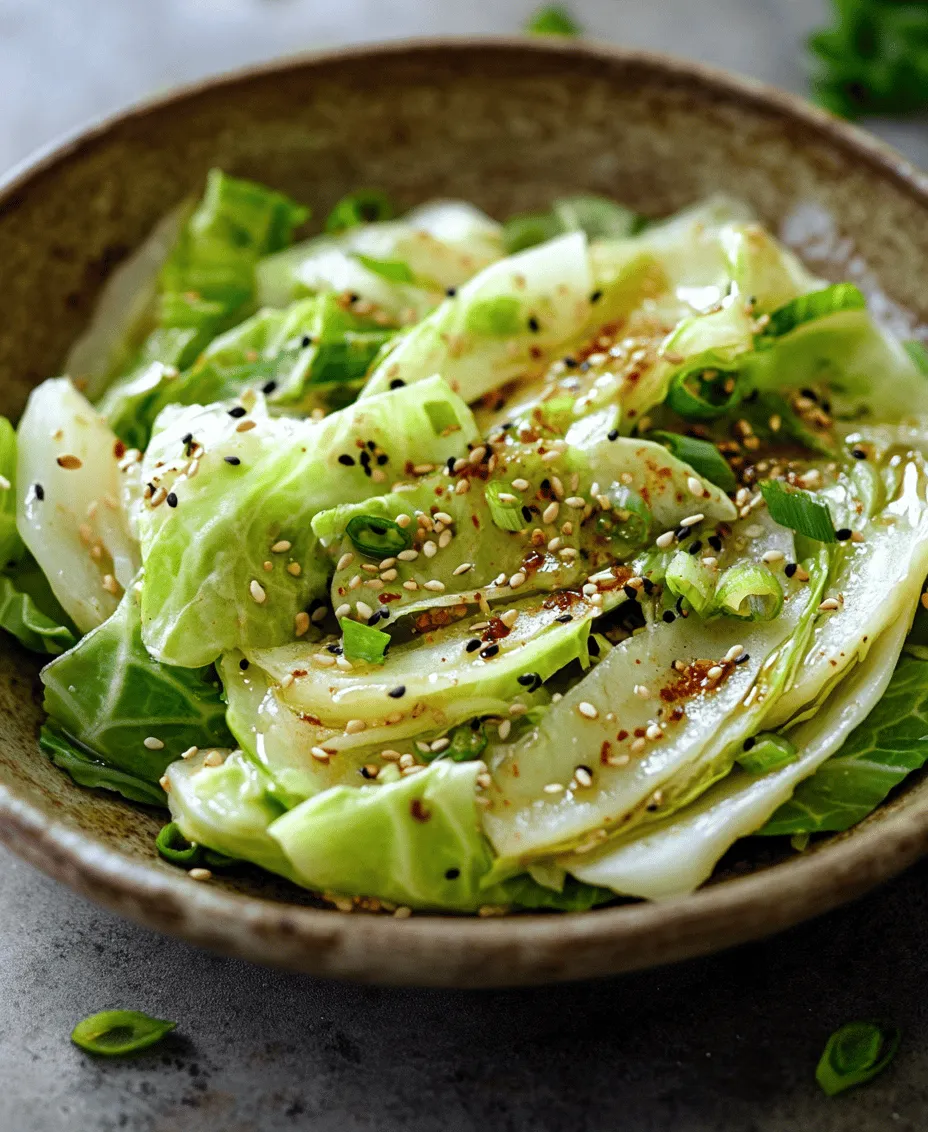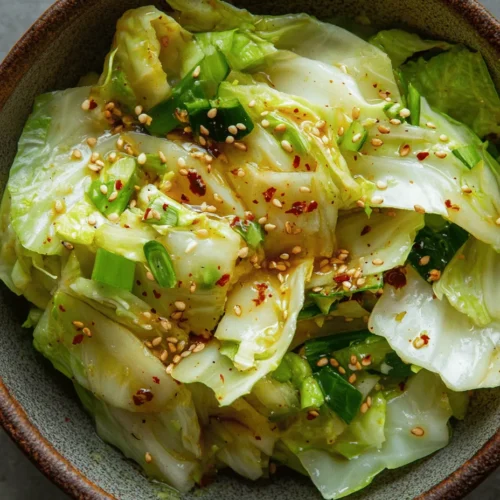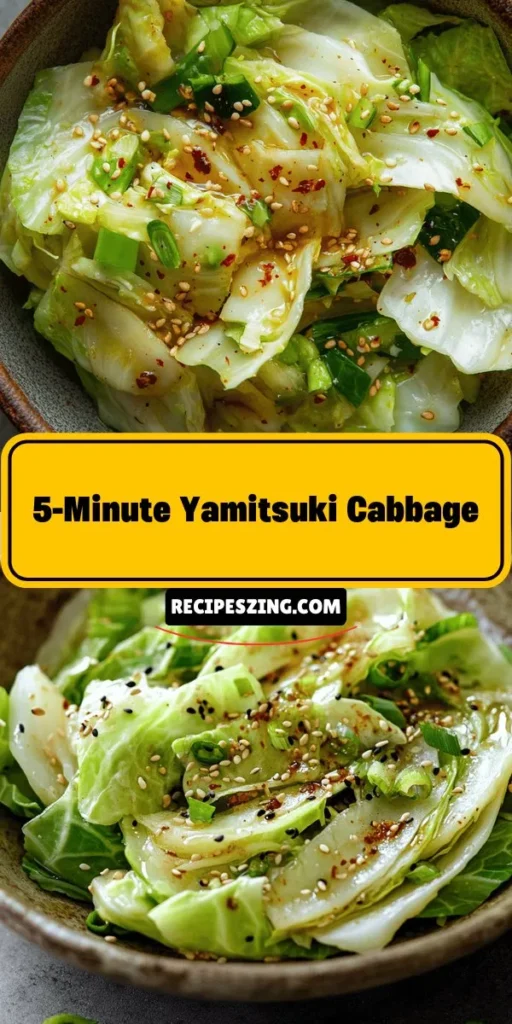Introduction
In the realm of quick and healthy recipes, the Crunchy 5-Minute Yamitsuki Cabbage stands out as a delightful and vibrant dish that captures the essence of freshness and flavor. This simple yet satisfying side dish is perfect for busy weeknights or a gathering with friends, serving as a great companion to various main courses. The combination of crisp Napa cabbage and a zesty dressing makes it a versatile addition to any meal.
Yamitsuki Cabbage is a traditional Japanese salad that showcases the delicate taste of Napa cabbage, also known as Chinese cabbage. The term “Yamitsuki” translates to “deliciously seasoned,” which perfectly encapsulates the dish’s essence. With its roots in Japanese cuisine, this salad has gained popularity globally for its refreshing crunch and the ease of preparation. In today’s fast-paced world, quick and healthy recipes are essential, allowing home cooks to create delicious meals without sacrificing time or nutrition.
Understanding Yamitsuki Cabbage
To appreciate Yamitsuki Cabbage fully, it’s important to understand the star of the dish: Napa cabbage. This leafy vegetable is characterized by its long, pale green leaves and crisp texture, making it an ideal candidate for salads and stir-fries. Napa cabbage is not only delicious but also boasts impressive nutritional benefits, including being low in calories while providing essential vitamins and minerals. It is rich in vitamins A, C, and K, along with folate and fiber, contributing to a well-rounded diet.
Yamitsuki Cabbage plays a significant role in various cuisines, particularly in Asian dishes. In addition to its popularity in Japan, Napa cabbage is commonly used in Korean kimchi, Chinese stir-fries, and even in salads across different culinary traditions. The versatility of this ingredient makes it a staple in many households, as it can easily adapt to different flavor profiles and cooking methods.
Essential Ingredients for Yamitsuki Cabbage
Creating the perfect Crunchy Yamitsuki Cabbage requires a handful of essential ingredients, each contributing unique flavors and textures to the dish. Here’s a detailed look at what you’ll need:
1. Napa Cabbage: The star of the dish, Napa cabbage, is celebrated for its crisp leaves and subtle sweetness. Its texture allows it to hold up well against dressings, making it the perfect base for this salad. When selecting Napa cabbage, look for heads that are firm, with vibrant, unblemished leaves.
2. Soy Sauce: This umami-rich seasoning serves as the backbone of the dressing. It adds depth and flavor to the dish. For those looking to reduce sodium intake, low-sodium soy sauce or tamari (a gluten-free alternative) can be excellent substitutes.
3. Rice Vinegar: Rice vinegar is used to balance the flavors, providing a gentle acidity that complements the sweetness of the Napa cabbage. It enhances the overall taste without overpowering the dish. If rice vinegar is unavailable, white wine vinegar or apple cider vinegar can be used as alternatives.
4. Sesame Oil: This ingredient adds a nutty aroma and flavor to the dressing. Toasted sesame oil, in particular, elevates the dish with its rich taste, while regular sesame oil offers a lighter profile. Choose toasted sesame oil for a more pronounced flavor.
5. Sugar: A small amount of sugar is added to enhance the overall flavor profile without making the dish sweet. It helps balance the acidity of the vinegar and the saltiness of the soy sauce, creating a harmonious dressing.
6. Chili Oil: For those who enjoy a bit of heat, chili oil can be adjusted to personal preference. A few drops can add a spicy kick, while omitting it altogether will keep the dish mild and family-friendly.
7. Aromatics (Green Onions, Garlic, and Ginger): These ingredients elevate the dish by adding layers of flavor. Green onions contribute a fresh, mild onion flavor, while garlic and ginger provide warmth and depth.
8. Toasted Sesame Seeds: Finally, toasted sesame seeds not only add a pleasant crunch but also enhance the dish’s appearance, making it more visually appealing. They are the finishing touch that ties all the flavors together.
Step-by-Step Instructions for Preparation
Preparing Crunchy Yamitsuki Cabbage is a straightforward process that takes just five minutes. Follow these step-by-step instructions to create this refreshing dish:
Preparing the Dressing
1. Whisking the Ingredients: In a small bowl, combine the soy sauce, rice vinegar, sesame oil, sugar, and chili oil (if using). Use a whisk to mix the ingredients thoroughly until the sugar is dissolved, and the dressing is well combined. The goal is to create a balanced dressing that is slightly sweet, tangy, and savory.
2. Tasting and Adjusting: After whisking, taste the dressing and adjust as needed. If you prefer it saltier, add more soy sauce; for additional sweetness, increase the sugar. This step ensures that the dressing suits your taste preferences.
Properly Slicing Napa Cabbage
1. Preparing the Cabbage: Rinse the Napa cabbage under cold water to remove any dirt or grit. Pat it dry with a clean towel or use a salad spinner to remove excess moisture.
2. Slicing the Cabbage: Using a sharp knife, cut the Napa cabbage into quarters lengthwise. Remove the core by slicing diagonally at the base of each quarter. Then, chop the cabbage crosswise into thin strips, about 1-inch wide. This technique ensures that the cabbage maintains its crunch while allowing the dressing to coat it evenly.
3. Incorporating the Aromatics: Once the cabbage is sliced, finely chop the green onions, garlic, and ginger. These aromatics will be added to the cabbage, enhancing the overall flavor profile of the dish.
By following these initial steps, you’ll set the stage for a delicious serving of Crunchy Yamitsuki Cabbage. In the next section, we will delve deeper into the assembly of the dish and additional tips for achieving the best results. Stay tuned as we continue this culinary journey to create a refreshing and flavorful side dish that will impress your friends and family.

Tossing Techniques for Even Coating of Dressing
Once you have your Yamitsuki Cabbage ready, it’s essential to toss it properly to ensure that every piece is evenly coated with the dressing. Start by placing all your cabbage and any other ingredients in a large mixing bowl. Using your hands is generally the best approach; gently lift the cabbage from the bottom and flip it over, allowing the dressing to coat the leaves without bruising them. This technique is particularly important to achieve a balanced flavor in every bite. If you’re concerned about getting your hands messy, you can use a pair of salad tongs, but be gentle to maintain the integrity of the cabbage.
For even more thorough coating, consider letting the cabbage sit in the dressing for a minute or two before tossing. This allows the flavors to penetrate the leaves slightly, enhancing the overall taste of the dish.
Importance of Resting Time for Flavor Development
Resting the cabbage after tossing it with the dressing is critical for flavor development. When you allow the Yamitsuki Cabbage to sit for about 10 to 15 minutes, the salt in the dressing draws moisture out of the cabbage, creating a light brine that enhances the overall flavor of the dish. This resting period also softens the cabbage slightly, making it easier to chew while preserving its crunch. During this time, the flavors meld together, resulting in a more harmonious taste.
Make sure to cover the bowl with a clean kitchen towel or plastic wrap to keep it fresh while it rests. If you prefer a stronger flavor, you can leave the cabbage to sit for up to 30 minutes, but be cautious not to let it sit too long, or it may become too soft.
Presentation Tips for Serving
When it comes to presenting your Yamitsuki Cabbage, a visually appealing dish can elevate the meal. Start by placing the cabbage in a shallow serving bowl to showcase its vibrant colors. To add an extra touch, consider garnishing with toasted sesame seeds, finely chopped scallions, or a sprinkle of red pepper flakes for an added pop of color and flavor.
If you want to enhance the presentation further, serve the Yamitsuki Cabbage in individual small bowls. This not only looks elegant but also allows guests to help themselves without the mess of serving from a communal bowl. You might also consider pairing the dish with contrasting colors, such as a bright carrot salad or a colorful beet dish, to create an appealing platter.
Flavor Profile and Pairing Suggestions
The flavor profile of Yamitsuki Cabbage is a delightful balance of crunchy, tangy, and slightly sweet notes. The base of the dish is the crisp cabbage, which provides a refreshing crunch, while the dressing, often made with soy sauce, rice vinegar, and sesame oil, adds a savory umami punch. The addition of optional ingredients, such as ginger or garlic, can enhance the complexity of flavors even further.
This dish pairs beautifully with a variety of main dishes. For a classic combination, serve it alongside grilled meats, such as teriyaki chicken or miso-glazed salmon. The refreshing crunch of the Yamitsuki Cabbage helps to cut through rich flavors, making it an excellent side. Additionally, it works well with vegetarian options, such as stir-fried tofu or vegetable tempura, providing a light contrast.
Yamitsuki Cabbage also shines as a topping for rice bowls or noodle dishes. A spoonful of the cabbage can add a fresh crunch to a bowl of soba noodles or a hearty ramen, enhancing your meal’s texture and flavor profile.
Variations and Modifications
One of the appealing aspects of Yamitsuki Cabbage is its versatility. You can easily adapt the recipe to cater to different dietary preferences. For instance, if you’re looking to make it vegan, simply replace any non-vegan ingredients in the dressing with plant-based alternatives. For example, you can use coconut aminos instead of soy sauce for a soy-free option, or swap out honey for maple syrup to keep it vegan.
Additionally, if you’re following a gluten-free diet, ensure that your soy sauce is gluten-free, or again, consider using coconut aminos.
For those looking to incorporate seasonal vegetables, feel free to experiment with other fresh ingredients. Radishes, cucumbers, or bell peppers can all add unique textures and flavors. You might also consider adding fruits, such as thinly sliced apples or pears, for a sweet contrast to the savory elements of the dish.
Culinary Techniques Utilized in Yamitsuki Cabbage
Quick pickling is a culinary technique that plays a significant role in enhancing the flavors of Yamitsuki Cabbage. By allowing the cabbage to marinate briefly in a mixture of vinegar, sugar, and salt, you can amplify its natural flavors while introducing a tangy kick. This technique is not only simple but also effective in preserving the freshness of the vegetables.
Using fresh ingredients in raw preparations is another key aspect of this dish. Freshness is essential for achieving the desired crunch and vibrant flavors in Yamitsuki Cabbage. Whenever possible, opt for organic or locally sourced produce, as they tend to have better flavor and nutritional value.
To maximize crunch and freshness in salads like Yamitsuki Cabbage, consider various cutting techniques. Shredding the cabbage thinly allows for better dressing absorption and a pleasing texture. Additionally, incorporating other crisp vegetables such as carrots or bell peppers can enhance the overall crunchiness of the dish.
The Cultural Significance of Cabbage Dishes in Asian Cuisine
Cabbage has a rich historical context in Asian cooking, often celebrated for its versatility and health benefits. In many Asian cultures, cabbage is a staple ingredient, utilized in various forms, from fermented dishes like kimchi to fresh salads like Yamitsuki Cabbage.
The role of cabbage extends beyond its culinary uses; it is also recognized for its nutritional benefits. Packed with vitamins C and K, fiber, and antioxidants, cabbage has long been associated with promoting health and longevity in various cultures. Its ability to be preserved through pickling or fermentation further underscores its significance in Asian culinary traditions.
Yamitsuki Cabbage reflects broader culinary trends by embracing fresh, simple ingredients, and highlighting the importance of balanced flavors. This dish serves as a reminder of the simplicity of Asian cuisine, where fresh produce takes center stage, and dishes are created with minimal processing for maximum flavor.
Conclusion
In summary, Yamitsuki Cabbage stands out as a simple yet versatile dish that can enhance any meal. Its quick preparation and refreshing flavor make it an ideal side dish for various cuisines, while its adaptability allows for creative experimentation with ingredients and flavors. Whether you serve it alongside grilled proteins, atop a rice bowl, or as part of a vibrant salad, Yamitsuki Cabbage is sure to impress.
As you explore different pairings and variations, don’t hesitate to make the dish your own. The beauty of Yamitsuki Cabbage lies in its ability to adapt to your preferences while maintaining its essence. Incorporating quick, healthy sides like this into your everyday meals can elevate your dining experience and encourage a more balanced approach to eating. Embrace the crunch, the flavors, and the simplicity of Yamitsuki Cabbage as you embark on your culinary journey.



